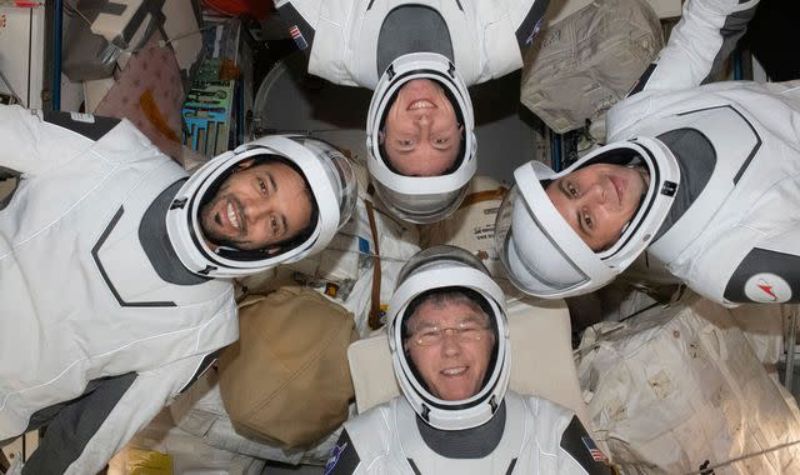
After a six-month stay on the ISS, SpaceX’s Crew-6 astronauts splash land.
- Science
- September 4, 2023
After completing their first extended space mission on the International Space Station (ISS), four astronauts have returned to Earth.
SpaceX’s Crew-6, which included NASA’s Stephen Bowen and Warren “Woody” Hoburg, the UAE’s Sultan AlNeyadi, and Roscosmos’ Andrey Fedyaev, splashed down on board the company’s Dragon spacecraft “Endeavour” at 12:17 a.m. EDT (04:17 GMT) on September 4 in the Atlantic Ocean off the coast of Jacksonville, Florida. Only Bowen has experience flying in space before of the four.
“When we showed up here six months ago, it was a new experience for all of us,” said Bowen during a brief farewell ceremony aboard the station on Thursday (Aug. 31). “I had been to space, but I’ve never been on a long-duration mission. This has been an absolutely incredible experience, and it’s been a great opportunity to watch my amazing crewmates as they’ve come along.”
The Crew-6 astronauts, who launched on March 2, completed their 186-day mission after working as flight engineers for Expeditions 68 and 69 of the International Space Station.
They were supposed to return home on Sunday morning (September 3), but bad weather caused them to linger in orbit for an extra day.
“It’s certainly been the experience of a lifetime and a real honor to get to spend six incredibly short-feeling months living and working aboard this incredible orbiting outpost,”Warren said during the same occasion.”I think we got a lot done. We started off with SpaceX [Commercial Resupply Services or CRS] 27 right away, a cargo vehicle full of science. Later, we had the SpaceX [CRS] 28 mission, as well we welcomed a visiting Axiom crew on board.”
“We did three spacewalks amongst our Crew-6. We berthed a Cygnus [cargo] vehicle. We did a lot of maintenance, and hopefully we’re leaving the space station just a little bit better than we found it,” said Warren.
The autonomous undocking of the Dragon Endeavour from the space-facing port of the Harmony node at 7:05 a.m. EDT (1105 a.m. GMT) on Sunday allowed the four astronauts to leave the space station.
The flight was not only AlNeyadi’s first, but also an Arab and an Emirati’s first extended trip. He follows Hazza AlMansoori’s brief, seven-day voyage to the space station in 2019 as the only other UAE astronaut to have flown. Saudi Arabia’s Prince Sultan Al Saud became the first Arab in space in 1985 when he launched on a NASA space shuttle.
“We had a good outreach with many people around the world, so it was really amazing —especially for my region,” said AlNeyadi. “I come from a place where human spaceflights were stopped for more than 30 years, and I felt that I was obligated to show what’s happening with the station. I think it was a small boost towards spreading the enthusiasm in our region.”
The Crew-6 zero-g indication, a tiny plush doll of the UAE astronaut program’s mascot “Suhail,” which also returned to Earth on Monday on the Dragon, was chosen by AlNeyadi.
Only the second Russian cosmonaut in history and the first Russian man to intentionally land on water was Fedyaev. He took a seat exchange deal between NASA and Roscosmos to travel on the SpaceX spacecraft.
SpaceX rescue boats, including the “Megan” (named after NASA astronaut Megan McArthur, one of the first women to fly aboard a SpaceX Dragon), were waiting nearby to assist in removing the spacecraft and its crew from the ocean.
After Crew-6 returned to Earth, NASA astronauts Frank Rubio and Jasmin Moghbeli, European Space Agency astronaut Andreas Mogensen, Japan Aerospace Exploration Agency astronaut Satoshi Furukawa, and Roscosmos astronauts Sergey Prokopyev, Dmitry Petelin, and Konstantin Borisov continued their Expedition 69 mission to the space station. When Prokopyev, Petelin, and Rubio board Russia’s Soyuz MS-23 spacecraft to leave the station in late September, Expedition 70 will officially get underway. Rubio’s 371-day stay in space set a new record for the United States.
It was SpaceX’s sixth crew rotation mission for NASA, seventh crewed space mission in aid of the American space agency, and ninth human space mission overall. Endeavour, which had previously flown the Demo-2, Crew-2, and Axiom-1 missions to and from the space station, made its fourth journey with Crew-6.